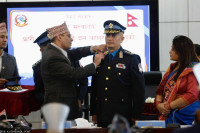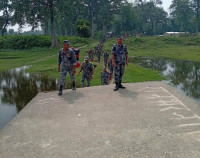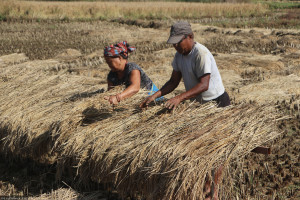National
China pledges Rs 16.8 billion in assistance for Nepal
The major takeaway of the agreement is that Nepal can use four Chinese seaports, three land ports for third-country import, and export through the six dedicated transit points between Nepal and China.
Anil Giri
China has pledged Rs16.8 billion (1 billion yuan) as economic and technical assistance to Nepal.
An announcement to this effect—and an agreement—is likely after the delegation level talks between President Bhandari and Chinese President Xi Jinping on April 29 in Beijing at the Great Hall of the People, said officials.
President Bhandari is currently on a state visit to the northern neighbour at the invitation of her Chinese counterpart Xi to participate in the Second Belt and Road Forum for International Cooperation.
A recent Cabinet meeting had decided to accept the Chinese assistance.
It is not fixed where the money will be invested, a senior official said. The assistance could be used in the expansion of the second phase of the Ring Road in Kathmandu, among other projects.
During the official visit of former President Ram Baran Yadav to China, Chinese President Xi had announced similar assistance, which was for the reconstruction of the Kodari Highway and oil and gas exploration in Nepal.
Apart from the announcement of economic and technical assistance, Nepal and China will exchange documents related to the Protocol to Transit and Transportation, an important part of the Nepal-China Transit and Transportation Agreement sealed during the first visit of Prime Minister KP Sharma Oli to the northern neighbour in 2016.
The major takeaway of the agreement is that Nepal can use four Chinese seaports, three land ports for third-country import, and export through the six dedicated transit points between Nepal and China. According to the agreement, Nepal will utilise China’s four seaports in Tianjin, Shenzhen, Lianyungang and Zhanjiang and three dry ports in Lanzhou, Lhasa and Shigatse.
Other pacts that are likely to be announced after the delegation level talks between Bhandari and Xi are on customs cooperation between the two countries, preventing the theft, clandestine excavation and illicit import and export of cultural property, and agreement on cooperation between the Nepal Bureau of Standard and Metrology and the Standardisation Administration of China.
Bhadari, who reached Beijing from Xi’an on Thursday, delivered a speech at the Second Belt and Road Forum for International Cooperation on Friday.
A joint communiqué will be issued after the conclusion of the Belt and Road Forum on Saturday where 37 world leaders are attending and hundreds of delegates are participating.
Every country which has signed the Belt and Road Initiative or is about to sign it will have their own important matters in the joint communiqué and Nepal’s specific concerns on BRI will be addressed, told Sushil Lamsal, deputy chief of mission at Nepal’s Embassy in Beijing, the Post over the phone.
Nepal became a part of the China-led global infrastructure initiative in 2017 and is negotiating at least nine projects with the Chinese under the framework of the Trans-Himalayan Multi-Dimensional Connectivity Network, which will also explicitly address Nepal’s concerns.
Addressing the forum on Friday, President Bhandari said that Asia is a powerhouse of the world economy and for the future of global prosperity, the region is well poised to play a pivotal role.
“A region with many rich civilisations, Asia’s future should be that of inclusivity and partnership. The far-sighted vision of President Xi to build a community of shared future for mankind through the Belt and Road Initiative carries a huge potential. It is an important framework for collaboration, for cooperation and for connectivity,” Bhandari said. “Mutual efforts for mutual benefit; inclusive development for fair and equitable world order; and green development for the good health of the people and planet embody its spirit.”
For a landlocked country like Nepal, the President said, connectivity is of paramount importance in its socio-economic development. “With enhanced connectivity, vast opportunities for trade, investment, tourism and people-to-people relations will open up. The development of Trans-Himalayan Multi-Dimensional Connectivity Network, including Nepal-China Cross-Border Railway, will boost connectivity not only between Nepal and China but also other countries in the region.”




 21.12°C Kathmandu
21.12°C Kathmandu















